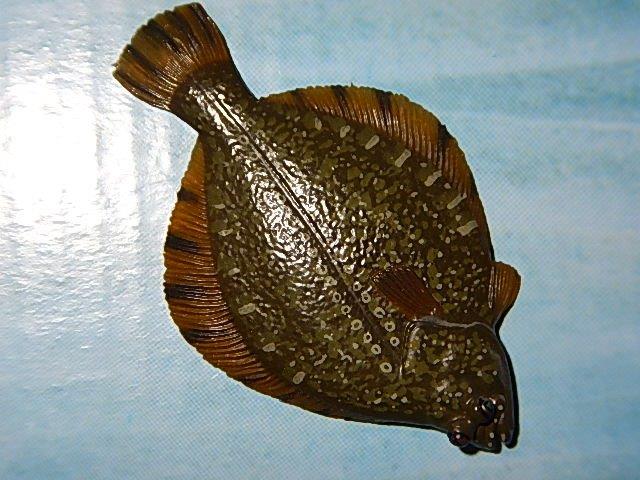
This figure is the Starry Flounder (or in Japanese, Kawagarei, among other names), Platichthys stellatus , model 31 and number 161 from the second series—and, sadly, THE LAST FIGURE IN THE SERIES! Which means that until/unless I get my hands on a representative of the ones I’m missing, or a few rare variants, this is the end of the line2 for the Yujin Freshwater Fishes Books 1 and 2. But I’m certain I’ll have more fish (and other figures) to follow up with! At least I can round it out with both versions of the last figure!
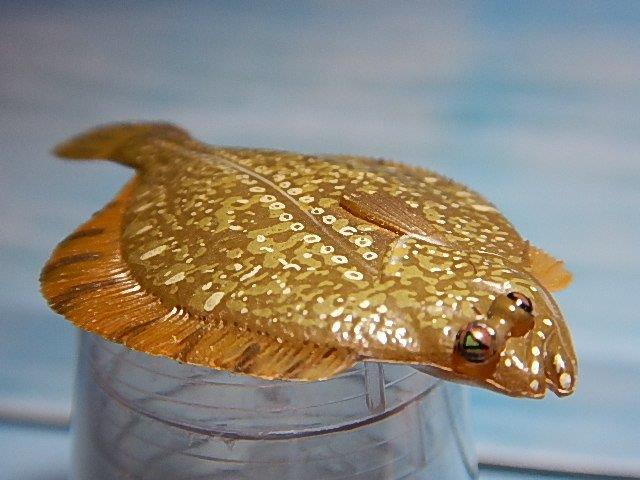

Of all the fish in the collection, the Starry Flounder may be the most distinctive. This is a ‘right-eye flounder’, meaning that as the fish grows into adulthood, the eyes tend to move over to the right side of the body (juveniles are born with eyes and body shape like a normal fish); sometimes the right eye moves to the left side of the body. They are predatory fish, eating fish, molluscs, crustaceans and even brittle stars. Like all flounders, the Starry Flounder is a master of camouflage, blending into the substrate to wait for prey and ambush it.
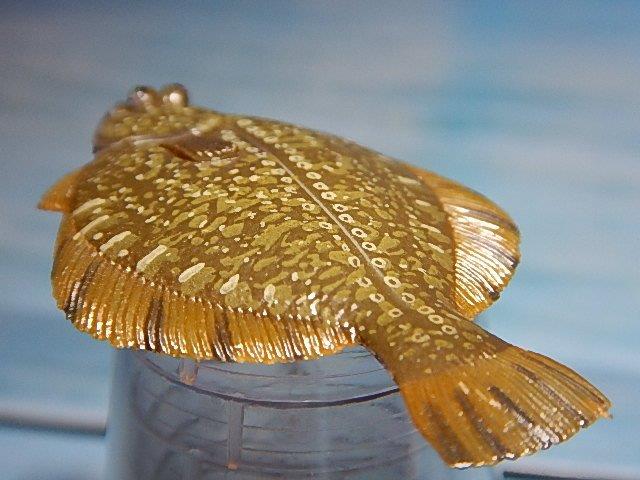
This Starry Flounder is an unusual one for the Freshwater series, given that flounders are usually thought of as marine animals. While flounders are generally marine, and potentially deep water marine, starry flounders are often found inshore and even in estuarine environments. They will, however, move far upriver, as much as 120km, possibly for breeding or at least growing into adults; but also move to deep water at certain times of the year. So, the starry flounder can be part of the Freshwater Series, why not? Starry flounders are important game fish as well as being commercially important to fisheries. They are found throughout the Northern Pacific, on both sides, meaning that they extend from Korea and Japan across to Alaska down the coast of Canada to the US Pacific. The Yujin model gives a length of 55cm, but most other sources I found gave a maximum size of 91cm. As of 2020 the IUCN listed the starry flounder as Least Concern.
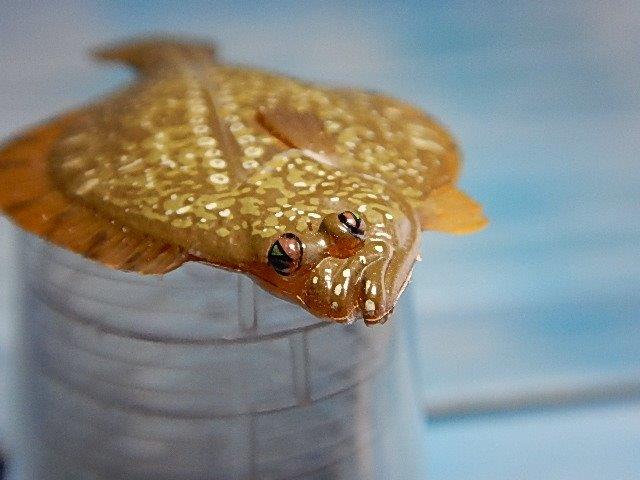
This model measures 6cm long, giving a scale of roughly 1:9 (1:15 using the length of 91cm). The starry flounder is in a flat pose—kind of boring, but as it is one that does not have a base, there was not much else that they could really do (unlike the Colorata halibut, which has a base and is in an undulating pose). Oddly, it is represented as a left-eyed individual, with the adult ventrum being what was the right side of the fish. Starting with the bottom, this fish is clearly a full grown adult, with no colour (it fades away after they transform) except some pink washes highlighting the sculpting around the head and lateral line. The muscle tissue is visible as white chevrons on the slightly darker-white background. The only ‘ventral’ fin, the right pectoral, is sculpted as an impression on the body, painted grey and white. The ‘top’ surface is far more colorful, of course.
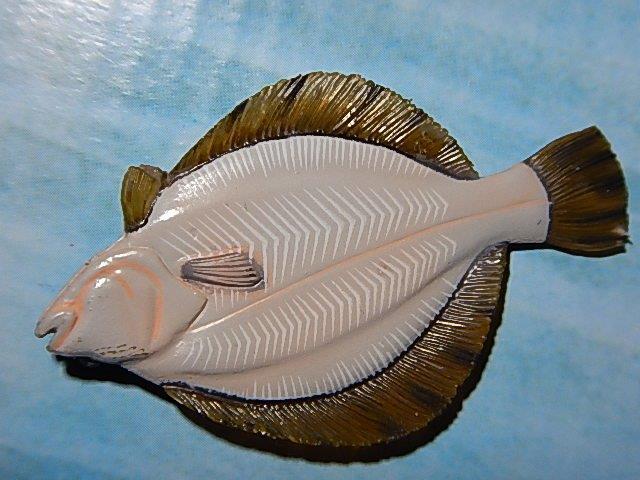
Like many flatfish, the starry flounder can be quite variable in its patterns, so Yujin appears to have gone all out! The body is a mixture of dark brown and olive-green, with numerous white markings along each edge (the original dorsal and ventral surface). On either side of the lateral line are a series of white circles from the gills to the base of the tail fin. The pelvic and ‘dorsal’ pectoral fins are a translucent orange. The dorsal and anal fin, as well as the tail fin, are also dark orange, with thick black bars along them. Yujin did a really good job with this, as these markings on the fins are (apparently) a reliable species identifier. The eyes, of course, are well done–big a bulbous, and placed very asymmetrically, with the ‘travelling’ eye near the original ‘top’ of the head, as it should be.
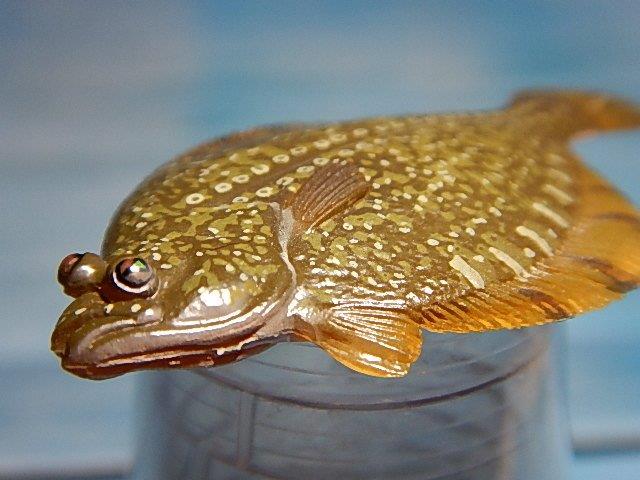
When it comes to other Starry Flounder figures, I can’t find any; even among other flatfish there do not appear to be a lot of them. I mentioned the Colorata one (from the Saltwater Fishes box), and there is a Kaiyodo ‘food fish’ set with a different flounder (it might be a starry, but I couldn’t definitively find its species). There are also strap and magnet figures from Yujin, which may be the same figure as the Freshwater Fishes one, but I don’t know for sure (the eel, for example, is completely different but not as good).

And yes, at some point I was able to get the Release 1 version of the starry flounder. As with most of the R1 figures, the paint is noticeably different. In the starry flounder, they are almost painted like different species (or, given some flounders’ ability to alter their colours to suit a substrate, they are from different surfaces). So unlike some figures, where the variation feels like ‘just’ an improvement, these two can reasonably represent different individuals just fine. Like the puffer, I apparently only took comparison photos.

The R1 has an even mix of dark brown with cream-colored margins and blotches with a smattering of small white dots. The R2, on the other hand, is more subtly colored with a range of browns and olive, and finer, smaller white markings throughout, along with a lot of black dots. This same patterning difference carries into the face. Even the dorsal and anal fins are very different. And on the ‘bottom’ of the fish (originally the ‘right hand side’) the paint is different, more yellowish .

And for the last time: Starting on the 14th of January, 2024, I migrated my first Yujin Freshwater Fish Pictorial walkaround post from the Animal Toy Forum to this blog, with the intention of moving all species’/figures’ walkarounds here. The initial post contained a lengthy explanation of the series (both the original and updated) that I don’t think should be repeated each time! For those details, the post can be seen at the first post. Then we can just get to the fish. Most of the details and writing will come from the original post, although I may supplement/add where appropriate.

From the Forum:
- Jetoar: Wonderful. It is the first time that I see a figure of a flatfish. The schema of color is really good and the detail of the eyes is one of the best points. Thanks you again
- brontodocus: Great! It’s even more interesting because it’s a flounder which means it’s left-eyed in contrast to other members of its family (the “righteye flounders”!)3. It’s a pity flatfishes are so rarely made as figures.
- technically, the secrets are 17 (egg+alevin), 18 (various domestic koi), and 19 (variously the secret goldfish or Japanese silver crucian carp, depending on release). But the numbering is all over the place with these sets. ↩︎
- For those curious, the missing figures are the 2 aforementioned secret koi figures (silver or gold) from Series 2; and the actual regular goldfish figure, number 2 in Series 2 (yes, a non-secret, but I have the secret version and no motivation for it); the amago red-spotted cherry salmon, a secret from the First release of series 1; and four figures released only with the special, all-encompassing box set after the Series 2 re-release; these were a gold/leucistic? char figure; a gold/leucistic? eel figure; the tricolor koi; and a beautiful white-spotted char – cherry salmon hybrid (which might have been some kind of mail away or bonus figure?). I recommend searching around for a picture of it. I’d love to get one…but it would take some serious funding and a forgiving spouse for that last one. If anyone wants to sponsor the effort I’m all ears :D. ↩︎
- I had to check and confirm…starry flounders are right-eyed although they can be either. ↩︎
Disclaimer: links to Ebay and Amazon on the AnimalToyBlog are affiliate links, so we make a small commission if you use them. Thanks for supporting us!



